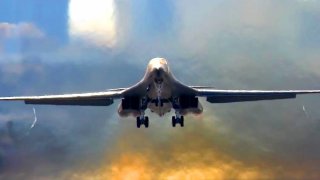Navy Officer: Take B-1 Bombers and P-8s and Form 'Patrol Bombing Squadrons'
The goal: sink Chinese warships in a war.
It’s no secret that the U.S. Navy wants to arm its P-8 patrol planes with new anti-ship missiles plus precision-guided bombs, mines and aerial decoys.
At the same time, it’s obvious that the U.S. Air Force is eager to find new roles for its aging, and potentially dwindling, force of B-1 bombers.
Now one Navy officer sees an opportunity for the two services to work together. Writing in Proceedings, the professional journal of the U.S. Naval Institute, Lt. Cmdr. John Leeds proposed that the Navy and Air Force combine the P-8s and B-1s into new “patrol bombing squadrons,” or VPBs, that would train to sink the Chinese fleet.
“Pairing the B-1 with the P-8 in maritime strike sensor-shooter teams would be a more effective solution for sea control than employing either platform alone,” Leeds wrote. “The P-8 has the sensors, data-links, range and experienced aircrews to perform maritime search and targeting, and the B-1 has the ability to carry large numbers of the [LRASM] long-range anti-ship missile.”
The jet-propelled P-8, 117 of which rapidly are replacing older, propeller-driven P-3s in Navy squadrons, already carries anti-submarine torpedoes, Harpoon anti-ship missiles and Standoff Land-Attack Missiles Expanded Response, or SLAM-ERs
But now the Navy wants to add Long-Range Anti-Ship Missiles, Joint Direct Attack Munitions, Small-Diameter Bombs, Mark 62/63/65 mines and Miniature Air-Launched Decoys. The fleet announced the addition in a February 2020 solicitation to industry.
The new weapons greatly would expand the kinds of targets the P-8 can attack. The Poseidon is a modified 737NG airliner with a new wing, military sensors and communications as well as an internal weapons bay and wing pylons for munitions.
The Air Force operates 62 B-1s at bases in Texas and South Dakota. After decades of hard use, the B-1s are in poor material condition and badly in need of upgrades. Modification programs and extensive depot maintenance have tied up many of the swing-wing bombers. Others are idle while awaiting spare parts.
Just seven of the 62 B-1 bombers were fully mission-capable in July 2019, South Dakota senator Mike Rounds revealed. The low readiness rate -- one of the lowest across the Air Force’s fleet -- weighed on the service’s plans for its bomber force.
While B-1 readiness improved in 2020, the Air Force still is asking Congress to allow the service to begin retiring -- years earlier than planned -- 17 of the least-reliable B-1s. The flying branch has considered arming at least 18 of the remaining 45 B-1s with a new, Mach-five hypersonic missile.
But the B-1 also carries the LRASM, a new 300-mile-range anti-ship missile. “Although both the P-8 and B-1 could do [surface-warfare] alone, lethality is maximized when their sensors, experience, and weapons are combined,” Leeds wrote. “A VPB force could strike enemy surface ships from outside the range of ship-based surface-to-air missiles.”
Leeds’s idea is for P-8s to spot ships and B-1s to lob missiles at them, although both types possess weapons and sensors and could swap roles. The question is how the Navy and Air Force would combine the planes.
Leeds proposed a “virtual VPB.” “The Air Force would keep B-1s in service and allocate flight hours to training in the maritime environment with P-8s. In return, the Navy would purchase a percentage of LRASMs for the B-1.”
“The Navy and Air Force would work jointly to improve survivability and countermeasures for both aircraft, including improved towed decoys and sensors,” Leeds added. “The B-1 would benefit from an infusion of Navy money toward improved survivability, while the P-8 could be fitted with something like an Air Force–provided AN/ALE-50 towed decoy system. The B-1 and P-8 weapon schools would coordinate closely. A permanent B-1/P-8 weapons and tactics instructor billet exchange could be established between the respective schools.”
David Axe is defense editor of The National Interest. He is the author of the graphic novels War Fix, War Is Boring and Machete Squad.

